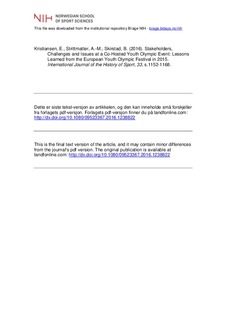| dc.contributor.author | Kristiansen, Elsa | |
| dc.contributor.author | Strittmatter, Anna-Maria | |
| dc.contributor.author | Skirstad, Berit | |
| dc.date.accessioned | 2018-04-30T10:51:54Z | |
| dc.date.available | 2018-04-30T10:51:54Z | |
| dc.date.created | 2016-11-02T15:25:14Z | |
| dc.date.issued | 2016 | |
| dc.identifier.citation | International Journal of the History of Sport. 2016, 33, 1152-1168. | nb_NO |
| dc.identifier.issn | 0952-3367 | |
| dc.identifier.uri | http://hdl.handle.net/11250/2496518 | |
| dc.description | I Brage finner du siste tekst-versjon av artikkelen, og den kan inneholde ubetydelige forskjeller fra forlagets pdf-versjon. Forlagets pdf-versjon finner du på tandfonline.com / In Brage you'll find the final text version of the article, and it may contain insignificant differences from the journal's pdf version. The definitive version is available at tandfonline.com | nb_NO |
| dc.description.abstract | The 12th European Youth Olympic Festival (EYOF) was arranged in Austria and Liechtenstein in January 2015. By using a stakeholder framework, the study aims to: (a) identify and differentiate between primary and secondary stakeholders based on their level of influence in planning, implementation and impact of the event; and (b) analyze the challenges and issues caused by the co-hosting. Qualitative data stemming from interviews, observations and document analysis indicate that EYOF is a less formalized event with a scaled down budget. The local stakeholders turned out to have most to gain and were willing to pay for such an event. Therefore, the Organizing Committee involved local sponsors, companies and communities, who became core or primary stakeholders, whereas the usual IOC core stakeholders played a reduced role. Major challenges in co-hosting were the coordination and administration of a border, two currencies, transportation and accommodation. EYOF as an international event might not have international influence, but it may have a sustainable impact on the communities due to the co-host. This implies that cohosting is a good model for future Olympic hosts if one wants to attract smaller countries, and have the benefits of cost-reduction, strengthening the community and cross-border relations. | nb_NO |
| dc.language.iso | eng | nb_NO |
| dc.subject | event management | nb_NO |
| dc.subject | youth sport events | nb_NO |
| dc.subject | legacy | nb_NO |
| dc.subject | Olympic organizing committees | nb_NO |
| dc.subject | stakeholders | nb_NO |
| dc.title | Stakeholders, challenges and issues at a co-hosted youth olympic event: Lessons learned from the European Youth Olympic festival in 2015 | nb_NO |
| dc.type | Journal article | nb_NO |
| dc.type | Peer reviewed | nb_NO |
| dc.description.version | acceptedVersion | nb_NO |
| dc.source.pagenumber | 1152-1168 | nb_NO |
| dc.source.volume | 33 | nb_NO |
| dc.source.journal | International Journal of the History of Sport | nb_NO |
| dc.identifier.doi | 10.1080/09523367.2016.1238822 | |
| dc.identifier.cristin | 1396692 | |
| dc.description.localcode | Seksjon for kultur og samfunn / Department of Cultural and Social Studies | nb_NO |
| cristin.unitcode | 150,33,0,0 | |
| cristin.unitname | Seksjon for kultur og samfunn | |
| cristin.ispublished | true | |
| cristin.fulltext | postprint | |
| cristin.qualitycode | 1 | |
